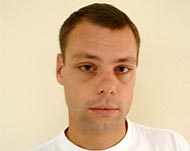Children targeted in Brazil’s drug war
Rafael used to be a drugs soldier and, as such, the victim of a worsening cycle of violence in Brazil’s slums. At the time he was just 15 years old.

Teenagers like Rafael are, according to the latest research, facing greater dangers than ever before. In the Israeli-Palestinian conflict, 467 children were killed between 1987 and 2001. In the same period in Rio de Janeiro alone, 3937 under-18s were killed due to small-arms related injuries.
With drug-related violence escalating, more children continue to die in Rio de Janeiro than in Palestine’s occupied territories.
And the situation is deteriorating. According to a former drugs-trafficker, the police now see children as deadlier than their adult counterparts – and act accordingly.
“Children have lost that aura of: ‘He’s only a child. We won’t shoot him.’ Now it is: ‘I will shoot more because their bodies are slimmer and more flexible; a child’s metabolism quicker, so I’ll shoot to kill. If I don’t shoot to kill, that kid will survive and come back and shoot me.’ So now they shoot to kill,” says the unnamed man.
Killer kids
Children are also trigger happy. Major Antonio Carlos Carballo Blanco, of the Rio de Janeiro military police, told researchers that: “The offensive potential of a child or adolescent with a firearm is much greater than the offensive potential of an armed adult.”
“Much due to the level of maturity of a child or adolescent, the possibility of him firing on a police officer is far more than that of an adult doing so,” he says.
 |
|
One of Rio’s beautiful beaches |
“You see kids have got military-grade weapons and grenades. It’s absurd,” says Luke Dowdney, a British anthropologist, former boxer and executive coordinator of Children in Organised Armed Violence, the body carrying out the latest study of child soldiers around the world.
Rafael’s story is typical. He lives in Complexo de Mare, one of Rio’s larger favelas (slums) with 120,000 inhabitants. It is strategically important for drug traffickers who work almost exclusively in cocaine and cannabis.
Last week, at least eight people died during a police raid there. One in six people in the city of Rio lives in favelas, including Rocinha, the biggest in Brazil, which overlooks the city’s famous beaches and Cidade de Deus, now known around the world thanks to the Brazilian film of the same name, City of God.
Street savvy
“I carried an assault rifle. If the police came, we had to shoot them; kill them or they would kill us,” says Rafael.
“The government wouldn’t do anything for us, so we took things into our own hands.
“We lived in a poor community with day-to-day violence and drugs, police shootings and bandit shootings.”
“My hero was a drug dealer (traficante). I saw him every day, armed and committing assaults. The traficantes help the community in a way that the government doesn’t. When my family didn’t have bread or money, it was the traficante who helped. So I became an armed soldier [for him],” he adds.
A solider or “soldado” provides armed security for the drug gang. He is paid up to $1000 a month to guard the drug-selling point in the favela and the community from invasion by police or by other drug gangs. The majority of minors working as soldados are between 15 and 17-years old. They are increasingly working as mercenaries in other favelas, allied to the same drug faction.
Inadequate laws
 |
|
Activists including Luke Dowdney |
When the optional protocol on involvement of children in armed conflicts was signed by 92 countries in 2000 it became the most advanced instrument of humanitarian law to date. It established a minimum age of 18 for recruitment and direct participation in hostilities.
However, this and other international instruments give little or no protection to children outside the parameters of war – including Brazil’s drug soldiers. Because Rio is not at war and there is no attack on the Brazilian government they are not classified as soldiers.
But Dowdney is still calling for increased awareness of children involved in organised violence because they are dying in greater numbers than those in countries at war.
“There is a mass proliferation of small arms around the world. Guns are available to kids of eight, nine and 10 years. They can carry them because of their weight and size,” says Dowdney.
Remedies sought
At a Rio conference in 2002, international child agencies defined children involved in organised armed violence as “children and youth employed or otherwise participating in organised armed violence where there are elements of a command structure and power over territory, local population or resources.”
 |
|
NGOs such as Viva Rio aims to |
The conference decided to study such children in 12 countries: Jamaica, El Salvador, Ecuador, Honduras, Philippines, Sierra Leone, Nigeria, South Africa, Haiti, USA, Northern Ireland and Colombia.
Preliminary findings do not make for happy reading.
“In South Africa, our researcher found that all the children interviewed in the area known as the Cape flats, in Cape Town, were armed by 13. And every one of them already had bullet wounds,” says Dowdney.
Moving forward
As part of the research Dowdney published his groundbreaking work Children of the Drug Trade: A Case Study of Children in Organised Violence in Rio de Janeiro last year.
The international study will report its full findings in July at the Neither War Nor Peace symposium in Rio de Janeiro.
“The focus is on what the kids are saying. One thing that is repeated time and again is power and status. Kids are affected by an enthusiasm for consumerism. Kids tend to join in where gangs are and when they have no other choices,” says Dowdney.
“Without fail, the one question that always gets the same answer though is: ‘Do you want your own son or daughter to be involved?’ ” he says.
That question set Rafael thinking. He quit when his girlfriend became pregnant. Now, aged 24, he has two children and is helping Dowdney in his Complexo de Mare boxing project.